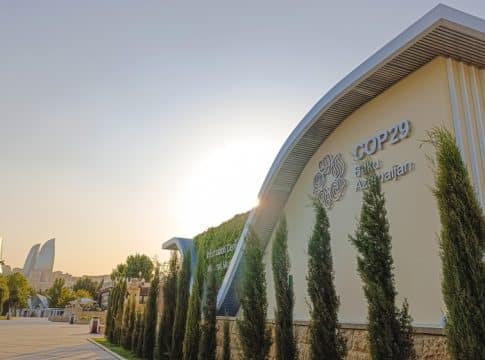Bank Of America Flags Liquidity Challenges in Carbon Markets: Will COP29 Usher in a New Era of Climate Finance?
This year’s COP29 summit will take place in Baku, Azerbaijan, from November 11-22. The focus will primarily be on delivering stronger climate finance and advancing a global carbon trading framework.
Interestingly, Bloomberg reported that Bank of America (BofA) has flagged liquidity concerns in carbon markets. It has highlighted the need for transparent and reliable trading standards, which is one of the key agendas of COP29. This is also a consequence of negotiators planning to change the dynamics of the carbon credit market in the future.
Here’s an in-depth look at what’s on the agenda for COP29 and why it matters.
COP29: Setting a New Climate Finance Target
For the first time since 2009, countries will meet at COP29 to reassess the funds required for climate action from developing countries. The decision will create a New Collective Quantified Goal (NCQG) for climate financing, which will replace the earlier fixed target of $100 billion per annum.
The NCQG aims to build the capacity of vulnerable nations to develop climate resilience and transition to low-carbon growth while protecting their communities from worsening climate impacts.
It’s already palpable that rising temperatures, extreme weather events, and increased costs for adaptation are imposing tremendous stress on developing countries. And this reassessment comes as a blessing during such inclement times.
Once there is mutual agreement on these issues, it will lay the foundation for carbon trading. This standardization will tackle liquidity challenges and broaden access to this facility for both developing and developed nations.
Bank of America Weighs in on Article 6.4 for the Future Carbon Credit Market
Article 6 of the Paris Agreement is another “high-stakes” topic to be discussed in COP29. Under this provision, countries are permitted to trade carbon credits with one another. Therefore, countries can meet their climate goals by investing in reducing emissions elsewhere.
For instance, a country rich in forest cover can sell credits generated from protecting its forests to fund its conservation efforts. The purchasing countries can then count these reductions toward their climate targets.
Negotiators are highly focused on Article 6.4, which sets up a new platform to harmonize carbon credit trading.
Abyd Karmali, Managing Director of ESG & Sustainable Finance at Bank of America, stated that Article 6.4 is vital for the future of the carbon credit market. He noted that this is a critical market and clear, legally binding standards are essential to ensure the carbon market supports emissions reduction goals.
Karmali is also an esteemed delegate who will be monitoring talks at the COP29 climate summit.
International carbon trading under Article 6, unlike the voluntary carbon market (VCM), will be subject to strict international oversight. These standards will help avoid some of the fraud and “greenwashing” charges that have plagued the voluntary markets and create a better and more trustworthy system for trading emissions reductions.
BloombergNEF’s Take on Carbon Trading
BloombergNEF has pointed out that new standards for carbon credits have boosted efforts to establish a global carbon trading system under the United Nations. However, these new guidelines seem to be weaker than the existing ones.
Even if they receive approval at the upcoming international climate summit in November, significant work remains to fully implement a mechanism that was first proposed in Article 6.4 of the 2015 Paris Agreement. However, experts hope that international standards can revitalize carbon trading and draw companies and governments away from the troubled VCM.
Layla Khanfar, a research associate at BloombergNEF, believes Article 6.4’s potential impact could be significant. She said,
“A finalized deal could lead to supply standardization and improve global liquidity. These are both valuable stepping stones towards a carbon credit market BNEF estimates could be valued at over $1 trillion by 2050.”
Voluntary Carbon Market’s Liquidity Problem
This leaves the VCM itself, in which nearly all corporations currently buy credits to offset their emissions, in deep trouble regarding liquidity.
We discovered from the same Bloomberg report that BofA has approached this market cautiously, citing low trading volumes and persistent accusations of greenwashing. These claims have eroded its credibility. According to MSCI, VCM volumes fell more than 20% last year, dropping to about $1 billion in trades.
Top companies such as Volkswagen, Telstra, and TotalEnergies have utilized the VCM as a method of balancing their emissions.
However, Karmali has said that “there’s simply not enough liquidity” to sustain it as a viable climate tool. He added that over the last two years, the market has experienced a steep decline, making it very difficult for participants to operate within the current systems.
The Transparency Milestone at COP29
COP29 marks the first full implementation of the enhanced transparency framework of the Paris Agreement. In this agreement, countries will have to submit their inaugural biennial transparency reports (BTRs) by the end of the year. These reports will contain details of their climate actions, including emissions reductions, adaptation strategies, and climate finance flows.
Subsequently, the Azerbaijani presidency launched the Baku Global Climate Transparency Platform to support this initiative. Notably, this platform particularly helps countries who are less familiar with climate reporting.
Transparent reporting will hold countries accountable and serve as a reliable resource for policymakers and stakeholders. The information in BTRs will be crucial for evaluating national climate commitments and identifying gaps in global action.
We expect COP29 will present an outstanding opportunity for a more sustainable and resilient future. Major emitters are stepping up with strong commitments, and financial institutions like Bank of America are backing these efforts. By encouraging collaboration and transparency, COP29 has all the potential to drive meaningful progress in carbon markets and climate finance.
Sources:
- BofA Calls Out Liquidity Barriers as Bankers Await CO2 Deal – BNN Bloomberg
- What to Expect at the 2024 UN Climate Summit (COP29) | World Resources Institute
The post Bank Of America Flags Liquidity Challenges in Carbon Markets: Will COP29 Usher in a New Era of Climate Finance? appeared first on Carbon Credits.



